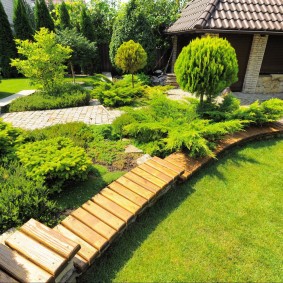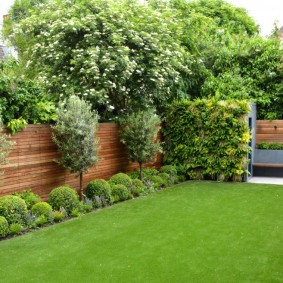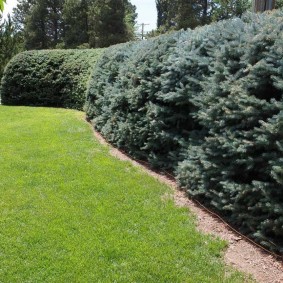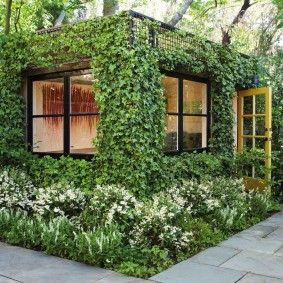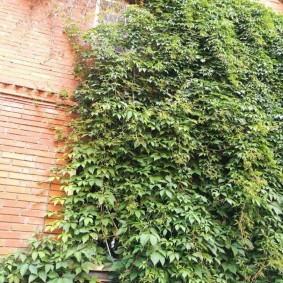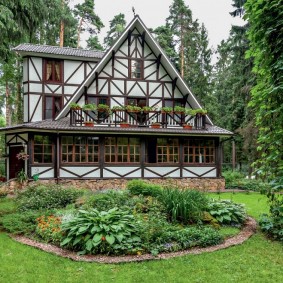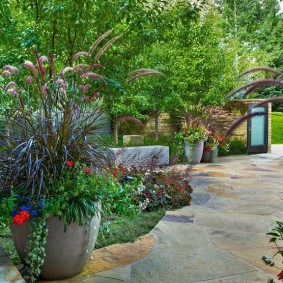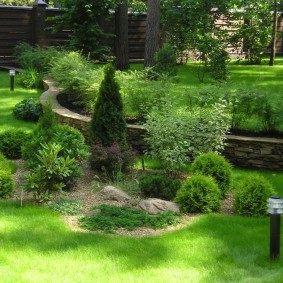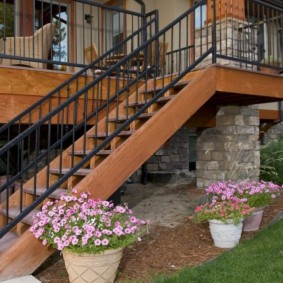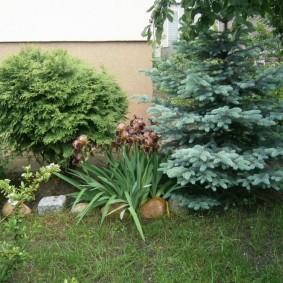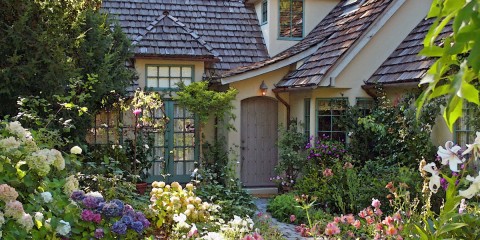 Landscape design
Receptions for registration of suburban areas - beautiful landscaping and decoration
Landscape design
Receptions for registration of suburban areas - beautiful landscaping and decoration
Country houses, dachas are being erected on land plots. After the construction of buildings, a comprehensive improvement is carried out, including landscaping of the site. Landscaping involves the adjustment of terrain, zoning, the arrangement of pedestrian walkways and roadways. Under the general concept of the project, green spaces are chosen. How to green the site correctly, taking into account the intricacies of the selection of plants, designers will prompt.

In summer, a lot of time is spent outside the walls of the house, and it is important to experience the same cosiness in the garden or in the yard as in the interior rooms.
The role of landscaping in landscaping
Content
Bright flower beds, picturesque rockeries (flower beds using stones, gravel), alpine hills complement the composition of the design of the territory. Trees, shrubs, hedges mask farm buildings, increase the aesthetic appeal of the object. Carpets of lawns create the effect of grooming, make landscaping complete.

Improving the area near a private house is no less important than arranging the interior of the house.
Plants perform the function of strengthening the soil on complex terrain, regulate soil moisture in flooded areas. Trees create a pleasant shade in recreation areas, on playgrounds. They help to zone the territory, make the landscape harmonious.
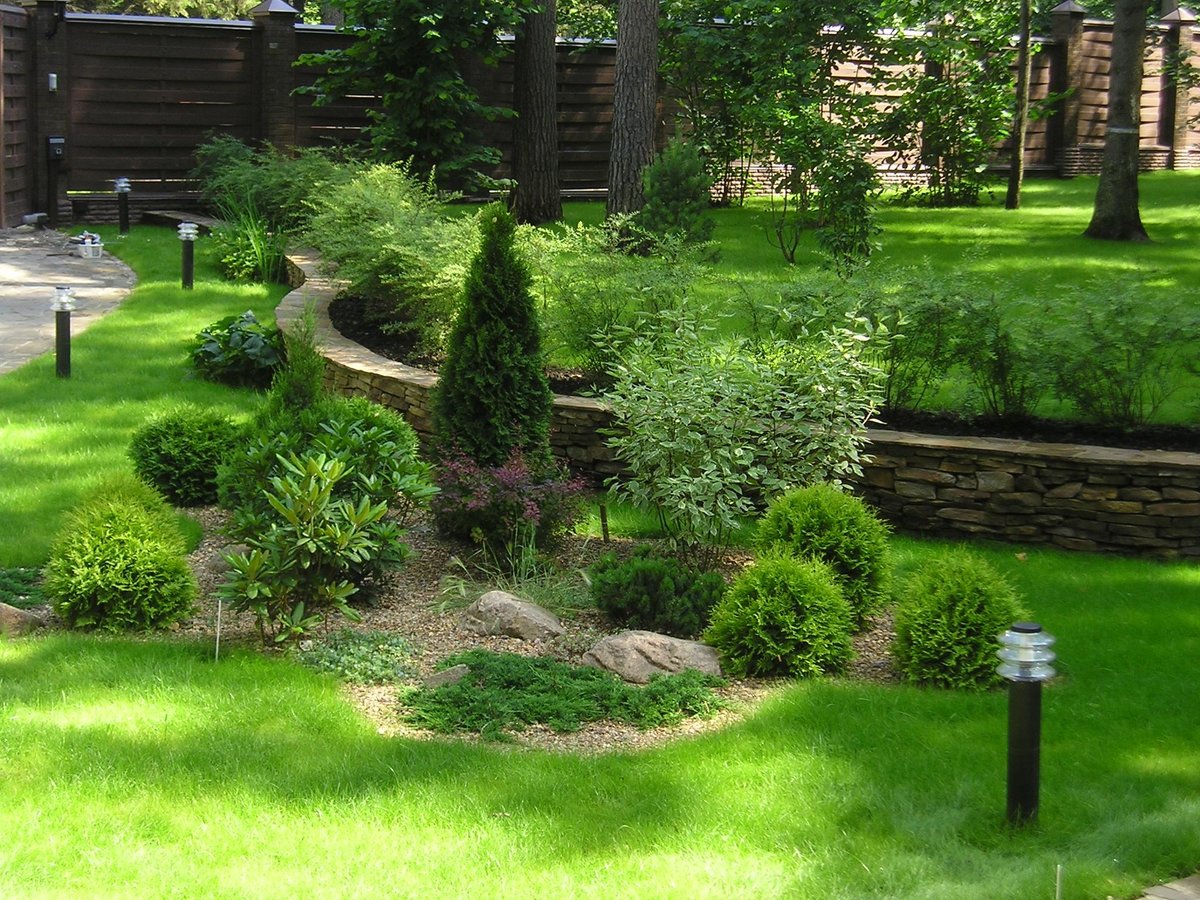
Green mass favors the creation of a pleasant microclimate, comfortable atmosphere.
Note! Saturated greens with bright interspersed floral and plant compositions emphasize the beauty of the site.
The main elements of landscaping
Designers identify three main areas of design, create a landscape based on:
- natural relief, choose plants, given the level of illumination, humidity, soil structure;
- flat lay-out, geometric layout of the plot in the style of English parks;
- multilevel artificially created sites.
When choosing green spaces, biological species are evaluated:
- for humid areas with a high level of groundwater occurrence, moisture-loving crops are chosen;
- drought tolerant grasses, flowers, and shrubs grow well on the hills;
- for shady areas, cultures that are undemanding in light are chosen.

You need to act in accordance with a pre-compiled plan that takes into account the features of the site: natural light, topography, soil moisture and other nuances.
Frost resistance of plants, a tendency to fungal diseases, and insect damage are taken into account. The choice of unpretentious species is a guarantee of well-groomed plot.

During planning, you should consider how the shadow from the buildings will fall.
Important! Perennials and shrubs for a temperate climate are best purchased in local nurseries where zoned varieties and hybrids are grown.
Lawns
Decorative grassy coating is a connecting element in the composition. Seed material is classified according to the purpose of the lawns, the possible load:
- The ground floor is not designed for walking, the height of the cover is up to 12 cm. The lawn serves as a backdrop for flower groups, sculptures, emphasizes the beauty of buildings.
- Ordinary or landscape gardening is sown by perennial creeping or cereal grasses forming a dense root network. The lawn is resistant to trampling, the cover requires regular “mowing”.
- Do not mow the meadow lawn.Grass grows naturally. Combine ground and flowering herbs.
- The Moorish lawn is also wild, with a colorful mosaic pattern. For registration use low-growing flowering grassy shrubs.
- The sports lawn is sown with branched plants forming a load-resistant green cover. The name is not accidental; you can play football on such lawns.
In specialized stores, they get a rolled one-year or two-year lawn, which is laid in layers on an even layer of soil. The survival rate of rolled lawns depends on the quality of grass care during growth, the method of transportation and pre-sale storage.

The lawn today is an integral part of any suburban housing.
For reference: there are two types of rolls. In soil, the soil is held at the expense of the roots formed, the mesh is additionally reinforced with polymer chain-link.
Hedges
Gardening of the summer cottage provides for the creation of hedges of various heights. Along the fence, nets are planted by thorny shrubs. A non-invasive fence can become a support for ampelous plants. Wild grapes, hops, and other climbing plants will beautifully curl along the wall.

Hedgerow as a tool for recreating different landscape design ideas.
Hedgerows make single-row and two-, three-row. By the shape of the hedge are divided into two categories:
- Free-growing form a hedge with a natural closure of crowns. Breeds are selected that give a small annual growth, forming an even crown in the form of cones, trapezoids, hemispheres. Permissible planting of stunted trees of the standard type.
- Molded shrubs are created from fast-growing shrubs, which from the haircut begin to branch actively, creating dense shapes of a given shape.
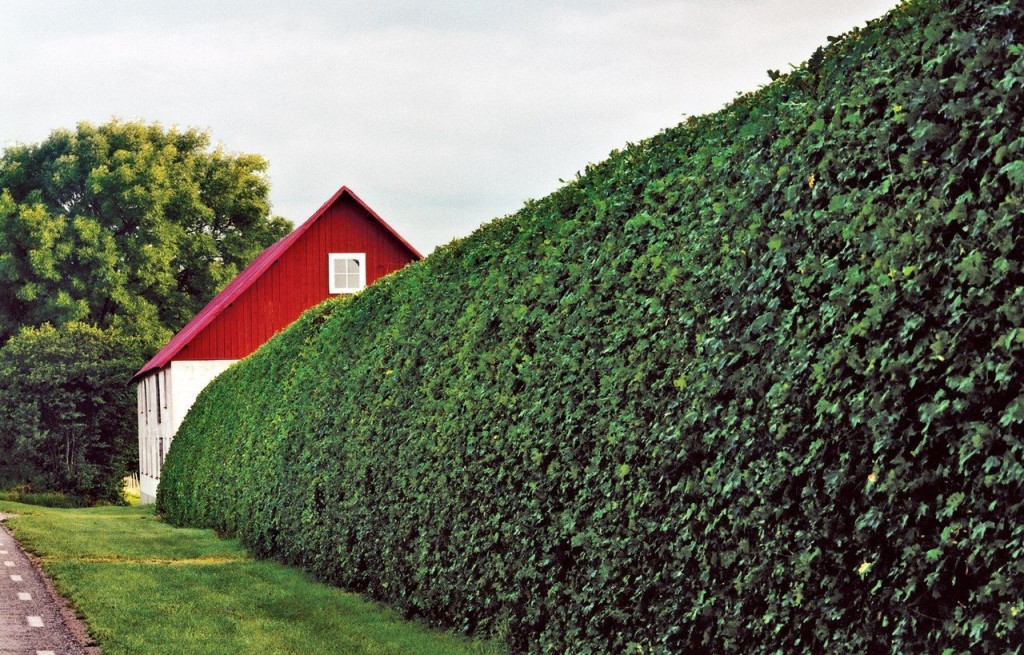
The plot along the hedge is filled with fruit trees or climbing bushes like hops.
Plants for hedges are divided into species groups:
- evergreens (conifers, cypress trees and shrubs, junipers);
- deciduous, dropping foliage in the fall;
- spiky;
- soft, with long shoots.
Practical hedges will protect from excessive curiosity of neighbors, protect from animals.
Flower beds and flower beds
Flower crops are appropriate in any landscape composition. When planning landscaping, you need to consider planting for quick landscaping of the site. These are annual and perennial flowering plants.

Flower beds and flower beds, this is a kind of frame, the artistic setting of the site.
Flowerbeds vary in shape, style and composition. A regular flowerbed provides clear boundaries between perennials, the simultaneous flowering of crops planted according to a certain plan. Irregular ones differ from regular ones in naturalness, a large number of species. Perennials with a different flowering period are usually selected so that throughout the season the flower beds look decorative.

They are arranged in the most visited and viewed areas of the site: front garden, courtyard, porch, recreation places.
For reference: flower beds with a vertical arrangement of flowerpots are called three-dimensional flower beds.
Vertical gardening
Align the slopes, uneven terrain will help multilevel or longline landings. The choice of plants for vertical gardening is limited by the possibility of co-growth. Combine creepers, ground cover creeping herbs and climbing flowering perennials.

Long lashes are flexible and can be guided along supports in the right direction, creating picturesque green walls.
Ampel flowers for vertical gardening are appropriate on slopes, cascading platforms, along wide steps, decorate arches, arbors.
Important! Vertical gardening is an ideal option for decorating retaining walls and other earthworks.

The advantage of vertical gardening is that it does not occupy the area at all, since the entire green mass of plants is in a vertical plane.
Artificial landscaping
In mountainous areas on the north side of the slopes, where ornamental plants do not grow well, resort to artificial landscaping. The decor does not need sunlight, the wind does not interfere. For phytoscene, lawn floorings are used, and all kinds of pot decor are used as plants.

In the same way, you can decorate the fence, the walls of outbuildings.
VIDEO: Original ideas for landscaping the site.
Examples of beautiful design landscaping a summer cottage
Successful landscaping projects of the garden are presented in a selection of photographs. Plants are selected separately for each of the zones. Unpretentious crops are planted in remote corners.
